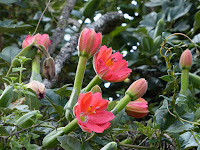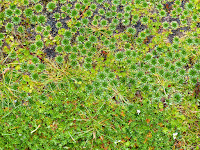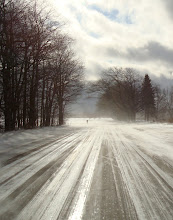- Transfer north to Otavalo, home of one of the most
important markets in the Andes Mountains.
Everywhere, you can see the handicrafts of the local indigenous Otavaleños,
one of the best known of the Kichwa tribes that preceded the Inca and Spaniards
in Ecuador. It is the opening of Carnaval- the partying that precedes Ash
Wednesday and the beginning of Lent for Catholics. Our initial urban hike to
Cascades de Peguche, a park with waterfalls, is hastily interrupted by the mobs
of teenage school kids throwing water balloons, bags of dyed flour, and shaving
cream sprays at each other and anyone who might make the mistake of walking
down the road. In the midst of all the craziness, a kids soccer game produced
the lineup of moms and stopped casual visitors just like anywhere around the
world!
A taxi ride brings us high into the hills above Otavalo to
El Lechero, an ancient gum tree said to have magical healing properties. It
surely healed us from the crazy time in the town below, providing vistas of the
checkered farmland and surrounding mountains in golden late afternoon light.




Our visit to the instrument maker ended in a family concert with a pint-sized flute player!
 |
| Otavalo market |
We travel back to Otavalo and the market - more tourist market than local, it is still heavily run by indigenous people who are more beautiful than the mostly machine made crafts they sell. Still....
The best sight of the day takes us back up into the hills to the
30 acre Parque Cóndor, which is a Dutch-owned foundation dedicated to
rescuing and rehabilitating birds of prey, including Andean condors, bald
eagles, owls, falcons and hawks. The
park sits on the steep hillside of Pucara Alto, a powerhouse site of pre-Inca
religious importance. (Ruins of a temple remain.) Spectacular views look across
to Imbabura volcano- located at a summit of Curiloma.





 |
| The intrepid 20 somethings! Henry, Leah and Nate |
Dining with four 25 year olds, three if whom are in the Peace Corps in Ecuador treats the rest of us to dinner conversation that is informed by their smart, thoughtful views, looking to the
world for inspiration and adventure, bringing to the world their fine spirits
and many skills. Lively discussion of the constitution, the Supreme Court, what
is uniquely creative to humans (language, art, symbolism), many aspects of
Ecuadorian culture, politics, and daily life. Love all these people...

Day four: 14 km hike
around Laguna de Cuicocha (the lake of the Guinea pigs!) near Cotacachi. Climbing to 10,000 on
the trail of the bromeliads - another sacred place, this time related to the
volcano nearby and the acidic crater lake created from it. The Kichwa of course had their beliefs about
it, but now it's a well maintained trail with climbs around the hills
surrounding the lake, covered all around with orchids, Passion flowers, and so
many lovely herbs... Subtle mints, medicinal plants, paper trees.


 Day five: We return to Quito. The tour includes the
surprising enjoyment of visiting Midad del Mundo, the exhibition of the equator.
With its strength-sapping and straight draining demonstrations, this tourist
site is actually very interesting. We
see the South American Union building, the old town streets and churches,
and our guide Giovanni's description of life in Ecuador- oil boom and bust, the
turn away from church-going if not the pageantry and idolatry is revelatory. I fell in love with the Madonna of Quito, with her angel wings
and 7,000 pieces of sculpted aluminum.. She dances above the city on Panecillo.
Day five: We return to Quito. The tour includes the
surprising enjoyment of visiting Midad del Mundo, the exhibition of the equator.
With its strength-sapping and straight draining demonstrations, this tourist
site is actually very interesting. We
see the South American Union building, the old town streets and churches,
and our guide Giovanni's description of life in Ecuador- oil boom and bust, the
turn away from church-going if not the pageantry and idolatry is revelatory. I fell in love with the Madonna of Quito, with her angel wings
and 7,000 pieces of sculpted aluminum.. She dances above the city on Panecillo.
 |
| Quito |
 |
| On the Equator- literally! |
 |
| Cuenca street |
Day 6: 5:00 am pickup
for the 7:00 flight to Cuenca brought us to a limited tour through nearly empty
streets as everything in Cuenca was closed for Carnaval.. even so, a way to focus
on the beauty of the colonial architecture, the street art, and the interesting
play of bridges and streets with the four rivers flowing through and converging
in this World Heritage site. Who knew the “panama” hat really hails from
Ecuador! Yet another market full of beautiful vegetables, fruits and flowers.
 |
| Beautiful murals and street art |
We stumbled on a final Carnaval parade of the baby Jesus from a gilded church through the streets..



Day 7: A highlight
in the activity sector, was cycling 35 km from Molobog to Ingapirca, the
most important Inca ruins in Ecuador, learning
about the Cañari indigenous culture, while passing through their villages
and farm landscapes. A beautiful
day with our guide Carlos leading the way. I call this “goddess cycling;”
stretches of flats and downhill punctuated by serious climbs, especially the
climb at the end. As the Cañari
women were the shamans, with their incantations and aromatherapy, they cleaned out
bad energy, let in the good, and I fancy that is what I’m doing as well.
The ride gave me time to think of
all the patroness women: St. Ann of Cuenca, the cloud virgin, the virgin of the
dew: healers and protectors.
Ingapirca is the largest Inca
ruin in Ecuador, and in keeping with Inca building practices, the Temple of the
Sun was constructed with huge stone blocks chiseled to fit together without
mortar. It is the only temple shaped elliptically, like the path of the sun. It
is also positioned so that on the solstices, sunlight falls through the center
of the doorway to the chamber at the top of the temple. The Cañari had enough knowledge of lunar
cycles and astronomy and building practices, to contribute to the Inca, that
they were allowed a fair measure of autonomy in contrast to other tribes that
were decimated or entirely absorbed.
 |
| Ingapirca |


 Our guide Carlos described how the Cañari and Inca used water
mirrors to reflect the moon and stars and as a calendar to determine crop
planting times, and how important Spondylus
shells were in foretelling rains and fertility (especially when, as now, they
were in an El Niño year.)
Shamans consumed Spondylus shell meat when they were seasonally toxic because
of their algae consumption in order to take advantage of their hallucinogenic
properties. Though Ingapirca is nowhere close to the ocean, many Spondylus
shells have been found there.
Our guide Carlos described how the Cañari and Inca used water
mirrors to reflect the moon and stars and as a calendar to determine crop
planting times, and how important Spondylus
shells were in foretelling rains and fertility (especially when, as now, they
were in an El Niño year.)
Shamans consumed Spondylus shell meat when they were seasonally toxic because
of their algae consumption in order to take advantage of their hallucinogenic
properties. Though Ingapirca is nowhere close to the ocean, many Spondylus
shells have been found there.

Day 8: Hike in
Cajas National Park.
Rain, cold, fog and mud did not
detour us from hiking above beautiful glacial lakes and around spongy mosses
and lichens, profuse flowering shrubs, and even at 13,000 feet,
"paper" trees. Eucalyptus, mint, valerian, and myriad other medicinal
herbs grow in profusion. After our hike and a late lunch we travel on to Guayaquil, and Nazu House- a B & B paradise before
we head to the Galapagos. . Sharing mangoes right off the
tree with wild parrots on the terrace at Nazu House was a delight!

 |
| Do, Bob, Henry, Leah and Nate |
 Day 9: Flight to
Baltra Island – 600 miles from Guayaquil- brings us to hot breezes as we board
the yacht Anahi for our tour of the eastern islands of the Galapagos
archipelago. Our first stop is Bachas Beach on the northern shore of Isla Santa Cruz, where we walk the beach to
see sea turtle nests, pelicans, a hunting heron, marine iguanas, red crabs,
flying wild flamingoes and a yellow warbler. Everything I’d heard about the
bountiful wildlife in the Galapagos, totally unafraid of humans, is true. An
animal lover’s and photographer’s paradise (if a HOT paradise!). First ocean swim very warm and salty... A word here about my fellow travelers. I couldn't imagine a more interesting or comfortable group of people to share an active and fast-moving vacation with. Good friends and neighbors at home, and great young (Spanish-speaking!) kids doing wonderful things with their lives make the best travel companions!
Day 9: Flight to
Baltra Island – 600 miles from Guayaquil- brings us to hot breezes as we board
the yacht Anahi for our tour of the eastern islands of the Galapagos
archipelago. Our first stop is Bachas Beach on the northern shore of Isla Santa Cruz, where we walk the beach to
see sea turtle nests, pelicans, a hunting heron, marine iguanas, red crabs,
flying wild flamingoes and a yellow warbler. Everything I’d heard about the
bountiful wildlife in the Galapagos, totally unafraid of humans, is true. An
animal lover’s and photographer’s paradise (if a HOT paradise!). First ocean swim very warm and salty... A word here about my fellow travelers. I couldn't imagine a more interesting or comfortable group of people to share an active and fast-moving vacation with. Good friends and neighbors at home, and great young (Spanish-speaking!) kids doing wonderful things with their lives make the best travel companions!
 |
| marine iguana |
 Day 10: Genovese
Day 10: Genovese
 |
| Male frigate bird |
 |
| red-footed booby |
Frigates, red-footed boobies, both brown and
white, two yellow crested herons, sea lions, fur seals, Eagle ays, colorful fish,
Galapagos doves, swallow tale gulls, a short eared own, sandalwood trees with their scented sap,
prickly pear cactus (replete with cactus finches) and the sandalwood for nesting in and perching, all seen
on Darwin Bay beach and Prince Phillips steps (El Baranco) hike on Genovese island. The soft breeze along the cliffs was beautiful, cooling and calming.
 |
| Galapagos doves |
 |
| Sea lion |
 |
| cactus finch |
 |
| yellow crested heron |
 |
| fur seal |

Day 11: An overnight transfer to South Plazas
Island and later to Isla Santa Fe brought us to another beautiful cliff walk
where we spotted storm petrels, and short eared owls, fly catchers, red billed
tropic birds, lava herons, blue footed boobies, and on a later snorkel from the boat, sea turtles,
and spotted eagle rays amidst the clown and blow fish. Dozens of land iguanas found only on Santa Fe
greeted us.
 |
| land iguana |
 |
| yellow warbler |

 Day one- Ann Arbor-DTW- Atlanta-Quito, Ecuador for first night at Zaysant Ecolodge, a little walled world unto itself outside the city with fruits and flowers growing everywhere, and very welcoming late at night for weary travelers.
Day one- Ann Arbor-DTW- Atlanta-Quito, Ecuador for first night at Zaysant Ecolodge, a little walled world unto itself outside the city with fruits and flowers growing everywhere, and very welcoming late at night for weary travelers.





 Our visit to the instrument maker ended in a family concert with a pint-sized flute player!
Our visit to the instrument maker ended in a family concert with a pint-sized flute player!












 Day five: We return to Quito. The tour includes the
surprising enjoyment of visiting Midad del Mundo, the exhibition of the equator.
With its strength-sapping and straight draining demonstrations, this tourist
site is actually very interesting. We
see the South American Union building, the old town streets and churches,
and our guide Giovanni's description of life in Ecuador- oil boom and bust, the
turn away from church-going if not the pageantry and idolatry is revelatory. I fell in love with the Madonna of Quito, with her angel wings
and 7,000 pieces of sculpted aluminum.. She dances above the city on Panecillo.
Day five: We return to Quito. The tour includes the
surprising enjoyment of visiting Midad del Mundo, the exhibition of the equator.
With its strength-sapping and straight draining demonstrations, this tourist
site is actually very interesting. We
see the South American Union building, the old town streets and churches,
and our guide Giovanni's description of life in Ecuador- oil boom and bust, the
turn away from church-going if not the pageantry and idolatry is revelatory. I fell in love with the Madonna of Quito, with her angel wings
and 7,000 pieces of sculpted aluminum.. She dances above the city on Panecillo.







 Our guide Carlos described how the Cañari and Inca used water
mirrors to reflect the moon and stars and as a calendar to determine crop
planting times, and how important Spondylus
shells were in foretelling rains and fertility (especially when, as now, they
were in an El Niño year.)
Shamans consumed Spondylus shell meat when they were seasonally toxic because
of their algae consumption in order to take advantage of their hallucinogenic
properties. Though Ingapirca is nowhere close to the ocean, many Spondylus
shells have been found there.
Our guide Carlos described how the Cañari and Inca used water
mirrors to reflect the moon and stars and as a calendar to determine crop
planting times, and how important Spondylus
shells were in foretelling rains and fertility (especially when, as now, they
were in an El Niño year.)
Shamans consumed Spondylus shell meat when they were seasonally toxic because
of their algae consumption in order to take advantage of their hallucinogenic
properties. Though Ingapirca is nowhere close to the ocean, many Spondylus
shells have been found there.











































